Puzzling times Sinclair McKay lets the pieces fall
Puzzling times Sinclair McKay lets the pieces fall into place When I was a lad, in the tawdry, tatty 1970s, a jigsaw was a thing of thin cardboard that came in a big box and featured, as the picture, the Houses of Parliament (soot-blackened) against an unnaturally vivid blue sky, with violently red buses in the foreground. There were 500 pieces and if they got chewed by the cat, the pictures on the pieces would become detached from the cardboard. Then the pieces would warp. And then half the effort of the thing would be the physical struggle to press these pieces into place.
These days — as with most pleasurable pursuits — things have moved on. And if one ever sees a jigsaw out on an occasional table now, the chances are that it is going to be a handsome, terrifically elegant and emphatically wooden thing. In the more rarefied end of the jigsaw world it is now possible to get personalised jigsaws, featuring photographs of loved ones; or circular jigsaws, which feature no giveaway straight edges and which can provide days of infuriation for all family members.
Pre-eminent among these aristocratic jigsaw pieces de resistance is the company Wentworth. Their puzzles can also be found in the shops of National Trust properties; each property is individually celebrated on the main image of the puzzles.
There will always be the old-fashioned jigsaw addicts who favour the cardboard variety, with images of kittens playing with wool in a wicker basket, because you get a million pieces for about £2.50. But many more are now looking for a more aesthetically pleasing style of jigsaw.
'Thing is,' says James Leith, a long-standing director of Wentworth and all-round jigsaw expert, 'cardboard jigsaws are actually rubbish. You get this vast box with a picture of the completed jigsaw and, inside, a little bag of all the pieces. They have their devotees because they are cheap, but they don't really have the lasting power of a wooden jigsaw.'
The other thing about a wooden jigsaw is that it can summon agreeable images of Wodehousian country parties, where everyone from the grumpy scion to the gay young things cannot pass the jigsaw on the hall table without attempting to fit another piece. 'Actually, it is now quite trendy to have a wooden jigsaw on a table in your house,' says Leith. 'But back in that era of garden parties, there was always a jigsaw around somewhere. Young lovers could rendezvous next to them, pretending to pore over their next moves.'
So do jigsaws, like many other culty enthusiasms such as Sudoku or Doctor Who, have a swivel-eyed fan base who demand that things have to be done in a very certain way? 'Jigsaw fans are very particular and everyone has their own opinion on what sort of image or shape works best,' says Leith. 'But there is one consistent thing: you get a severe bollocking from the fans if you make puzzles that are too easy.'
Wentworth purveys jigsaws at the extremely swanky end of the scale: particularly smart is the Platinum Puzzle, which is made from cherrywood plywood composite (but which is also, as the company is keen to point out, `sustainably sourced'). But there is also succour for those who feel that jigsaws should ideally have one foot in the past. 'The bestselling genre of jigsaw really is nostalgia,' admits Leith. 'Puzzles bearing images of railways trains in the golden age of steam — we use accredited railway artists — are extremely popular. Also tremendously popular is the art genre: people love to have wooden jigsaws of Monet or van Gogh. My own favourite style of jigsaw image is pre-Raphaelite.'
It is clearly time for the wooden jigsaw to take its rightful place back at the centre of the occasional table. And Leith provides one of the best reasons why. 'Unlike Sudoku, or listening to The Archers,' he says, jigsaw puzzlesolving is one of the few activities you can do while you are talking. Having said that,' he adds, 'some people do lock themselves away to solve puzzles, for fear that someone will look over their shoulders and put a piece in. This is why puzzles are popular even among the iPod generation. If younger family members see someone older getting stuck, they simply cannot resist sticking their noses in.'
Wentworth Wooden Jigsaws can be found at www.jigsaws.co.uk












































































 Previous page
Previous page